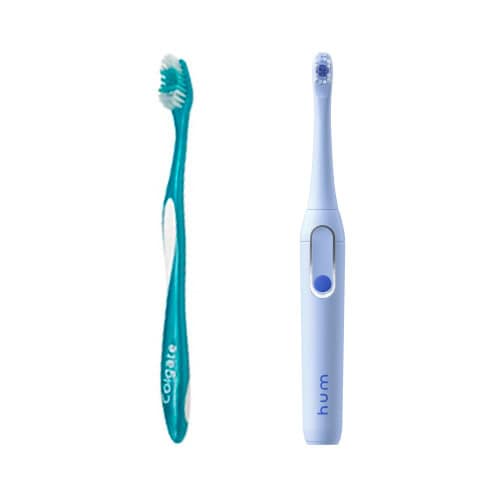The question that dental professionals get asked the most often? 'Should I use a manual or electric toothbrush?'
Patients come to dental professionals as they value their opinion and advice on the best self-care at home so that they can achieve optimal oral health. Of course, the first place to start is with a suitable toothbrush. There are several benefits and situations for both manual and electric toothbrushes, and some patients will have strong preferences for either of them.
Manual toothbrushes
Manual toothbrushes are a staple and affordable option for many patients. If your patient wishes to use a manual toothbrush, it is important to ensure they have a toothbrush with the appropriate bristle configuration, head size and that they are using the brush with the correct technique. Brushes with smaller heads can better access hard-to-reach areas. Medium bristles should be recommended for the majority of patients or situations, unless there are indications to use soft bristles, for example, after having dental surgery. Always remind patients to review and replace their toothbrushes regularly - at least every 3 months, or sooner if they experience sickness or the bristles of the brush begin to flare.
Patients should also be counselled into proper toothbrushing technique without being too aggressive which can cause damage. Patients need to brush for a full two minutes and there have been innovative new designs in the manual toothbrush market. The Colgate Magik brush, for example, uses augmented reality and apps to help children learn good brushing habits.
Manual brushes are available for specific indications and patient groups. For example, for patients with dentin hypersensitivity, the Colgate 360 Enamel Health toothbrush is a good option and helps with gentle cleaning. If patients have difficulty accessing and cleaning hard-to-reach areas, a toothbrush with a small slim head like the Colgate SlimSoft can be recommended. This brush also has thin bristles that help reach and clean in tight spaces between teeth and at the gumline.
Power (electric) toothbrushes
There is evidence to indicate that power toothbrushes are at least as effective for plaque removal as manual toothbrushes. Options include oscillating, rotating, oscillating-rotating, sonic-vibration and ultrasonic power toothbrushes.
Some patients prefer using power toothbrushes and many dentists recommend these for their patients. Some patients might prefer power brushes to toothbrushes if they have limited manual dexterity, for example, people with Parkinson's or other degenerative diseases. Also, the toothbrush handles of electric toothbrushes are usually thicker than manual toothbrushes, which some patients might find easier to grip, for example people who have arthritis.
Conversely, there are patients who do not like using powered toothbrushes, for example people who have sensory issues such as individuals with autism, who may dislike the vibration from the toothbrush. Power toothbrushes also require a financial investment, which some patients may not be able to afford, although more affordable options are now available.
Recently, power brushes with apps have become available, such as the Colgate hum. This affordable brush tracks brushing, giving patients immediate feedback and guidance while they are brushing, including areas they may be missing, duration of brushing for each area. Smart sensors incorporated into the brush provide the feedback, and the app visually shows patients all surfaces they should brush and highlights each section as they are brushing.
When deciding on which type of toothbrush to buy or to recommend for patients, there are different factors to consider for each patient to provide a personalized recommendation. It is of course always important to educate and encourage our patients to keep a frequent and consistent habit of good brushing and using an appropriate technique - no matter the type of toothbrush used.


Was this article helpful?
If you’d like a response, Contact Us.